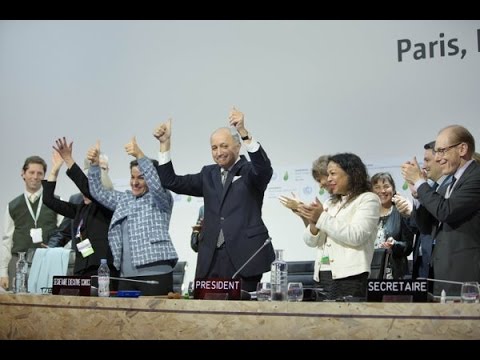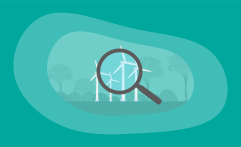The History of Nuclear Fission: The Big Picture
Affiliate Disclosure
Hey fellow impactful ninja ?
You may have noticed that Impactful Ninja is all about providing helpful information to make a positive impact on the world and society. And that we love to link back to where we found all the information for each of our posts.
Most of these links are informational-based for you to check out their primary sources with one click.
But some of these links are so-called "affiliate links" to products that we recommend.
Why do we add these product links?
First and foremost, because we believe that they add value to you. For example, when we wrote a post about the environmental impact of long showers, we came across an EPA recommendation to use WaterSense showerheads. So we linked to where you can find them. Or, for many of our posts, we also link to our favorite books on that topic so that you can get a much more holistic overview than one single blog post could provide.
And when there is an affiliate program for these products, we sign up for it. For example, as Amazon Associates, we earn from qualifying purchases.
What do these affiliate links mean for you?
First, and most importantly, we still only recommend products that we believe add value for you.
When you buy something through one of our affiliate links, we may earn a small commission - but at no additional costs to you.
And when you buy something through a link that is not an affiliate link, we won’t receive any commission but we’ll still be happy to have helped you.
What do these affiliate links mean for us?
When we find products that we believe add value to you and the seller has an affiliate program, we sign up for it.
When you buy something through one of our affiliate links, we may earn a small commission (at no extra costs to you).
And at this point in time, all money is reinvested in sharing the most helpful content with you. This includes all operating costs for running this site and the content creation itself.
What does this mean for me personally?
You may have noticed by the way Impactful Ninja is operated that money is not the driving factor behind it. It is a passion project of mine and I love to share helpful information with you to make a positive impact on the world and society. However, it's a project in that I invest a lot of time and also quite some money.
Eventually, my dream is to one day turn this passion project into my full-time job and provide even more helpful information. But that's still a long time to go.
Stay impactful,
Although nuclear fission (commonly only referred to as nuclear energy) has a rocky history in terms of public opinion, it can be an efficient and clean energy substitute for fossil fuels. Over the years, nuclear fission has evolved into our second-largest source of low-carbon energy. So, we had to ask: What is the history of nuclear fission?
Nuclear fission began in 1938 with the direction of the first man-made nuclear chain reaction involving Uranium. Then, the first nuclear power plant was constructed in 1954. The post-World War II era saw rapid development and led to nuclear being our second-largest source of low-carbon energy today.
One way to combat the current global climate crisis threatening Earth’s environmental, economic, and social health is to transition away from traditional fossil fuels and toward cleaner energy sources, such as nuclear energy. Keep reading to learn how nuclear fission came to be, who and what pioneered its development, how effective it has been thus far, and what the future of nuclear energy could entail.
Here’s the History of Nuclear Fission in a Nutshell
Nuclear fission, one of two ways to produce nuclear energy, is the generation of energy produced when splitting apart the nucleus of an atom.
“Nuclear fission: a nuclear reaction in which a heavy nucleus splits spontaneously or on impact with another particle, with the release of energy.”
Cambridge Dictionary
All operating nuclear power plants today utilize the process of nuclear fission. Because of this, nuclear fission is commonly referred to as ‘nuclear energy’ in the data and literature.
Nuclear fission has gone through three distinct development phases in its development:
- Early market formation and innovation: The early history of nuclear fission dates back to the late 1800s, with studies about the science of atomic radiation, the atomic model, and nuclear fission.
- Consolidation and strengthening: The accidental creation of the first man-made nuclear chain reaction in 1934 and the subsequent validation of the nuclear fission process in 1938 kickstarted the nuclear energy movement. From 1950-2000, there was rapid capacity and technology growth.
- Mainstreaming: Nuclear energy began to establish itself as a part of the mainstream electricity industry in the 1960s, with the opening of the first commercial nuclear power plant and rapid scaling of the technology post World War II. The establishment of the International Atomic Energy Agency (IAEA), the International Energy Agency (IEA), and the World Nuclear Association (WNA) helped to regulate the nuclear energy market.
| Nuclear Fission Milestones | Historical Event |
| Initial start | The early history of nuclear fission dates back to the late 1800s, with studies about the science of atomic radiation and the atomic model. |
| Milestones in nuclear fission development | 1934: Enrico Fermi unknowingly directed the first controlled chain reaction involving nuclear fission. 1938: Otto Hahn and Fritz Straßmann experimentally proved the process of nuclear fission. 1938: Lise Meitner and Otto Frisch theoretically proved the process of nuclear fission. 1939: Otto Frisch and William Arnold coined the term “fission”. 1939-1945: Nuclear development was focused on the making of the atomic bomb during World War II. 1956: Calder Hall, the world’s first commercial nuclear power station, became operational. 1960-2000: Nuclear energy generation increases from 25 TWh to over 2,500 TWh. 2000-present: Nuclear energy generation has remained relatively stable. Research into the process of nuclear fusion has increased. |
| Current status | Currently, nuclear energy accounts for roughly 10% of global electricity generation, generating approximately 2,500 TWh of electricity from approximately 413 GW of installed capacity. |
| Future outlook | The future of nuclear fission faces an uncertain future. Although it can produce relatively emissions-free energy and adjust its energy output to compensate for shifts in renewable energy output, it also faces high upfront costs and negative public opinion. Overall, the IEA has labeled nuclear energy as ‘more efforts needed’ in their Net Zero by 2050 Scenario in terms of capacity and investments. |
| Key policy developments | 1957: International Atomic Energy Agency (IAEA) 1974: International Energy Agency (IEA) 1994: Nuclear Energy Institute (NEI) 1998: World Nuclear Transport Institute (WNTI) 2001: World Nuclear Association (WNA) 2015: Paris Climate Agreement |
Understanding nuclear energy’s history can provide insight into how it has evolved into the energy source it is today.
When and How Did Nuclear Fission Get Started
Radioactivity has always been present on Earth, but it wasn’t seriously studied until the late 1800s. The early history of nuclear fission involves studies about the science of atomic radiation and the atomic model.
1789: German chemist Martin Klaproth discovered the element Uranium, which would become the foundation of modern nuclear fission.
1896: French physicist Henri Becquerel discovered the concept of radioactivity, the release of energy from atomic nuclei. His studies focused specifically on Uranium.
1897: British physicist J.J. Thompson discovered the electron, (he also received the Nobel Prize in Physics in 1906 for this discovery).
1911: New Zealand physicist Ernest Rutherford articulated his concept of the atom called “the Rutherford model”. It depicted a dense, positively-charged core called the nucleus surrounded by circulating, negatively-charged particles called electrons. This was the first primitive model of the atom.
1913: English chemist Frederick Soddy coined the term “isotope” to refer to chemically identical atoms with different atomic weights. Isotopes would become key in the formation of the modern nuclear industry.
1919: Danish physicist Niels Bohr articulated his concept of the atom called “the Bohr model”. His model was similar to Rutherford’s, but Bohr’s model depicted electrons that were confined to particular orbits, with electromagnetic radiation from an atom only occurring when electrons jumped to a lower-energy orbit. This was the first modern model of the atom.
1932: James Chadwick discovered the neutron, the part of the atom that is split apart during the process of nuclear fission. This led to the discovery that due to a differing number of neutrons, elements can exist at different weights but still have the same chemical properties.
How Has Nuclear Fission Developed Over Time
Nuclear energy is currently our second-largest source of low-carbon energy behind hydropower energy. It can play an important role in the global energy transformation and help us transition away from fossil fuels.
What Are Milestones in Nuclear Fission Development
The accidental creation of the first man-made nuclear chain reaction and subsequent validation of the nuclear fission process kickstarted the nuclear energy movement.
1934: Italian physicist Enrico Fermi unknowingly directed the first controlled chain reaction involving nuclear fission. He bombarded more than 60 elements, one of which was Uranium, with neutrons. He thought he had produced elements beyond Uranium when he had actually split apart the atom.
1938: German radiochemists Otto Hahn and Fritz Straßmann experimentally proved the process of nuclear fission. Bombarding Uranium with neutrons produced barium, which was deemed too light to be just a decay product of Uranium. They hypothesized that the Uranium atom had been split into two distinct atoms. This discovery would shape the modern nuclear industry.
1938: Austrian physicists Lise Meitner and Otto Frisch theoretically proved the process of nuclear fission, the splitting of the Uranium atom, which was carried out experimentally by Hahn and Fritz.
1939: Otto Frisch and William Arnold coined the term “fission” to refer to the splitting of an atomic nucleus.
1939-1945: Most nuclear development was focused on the making of the atomic bomb during World War II.
1956: Calder Hall, the world’s first commercial nuclear power station, became operational in the United Kingdom. It had a 49 MW capacity and remained operational for 47 years before closing in 2003.
1960-2000: Nuclear energy generation increases from 25 TWh to over 2,500 TWh as more and more power stations were constructed worldwide.
2000-present: Nuclear energy generation has remained relatively stable. Research into the process of nuclear fusion, the other way to generate nuclear energy, has increased.
How Has the Nuclear Fission Market Developed Recently
From 1950-2000, the nuclear energy industry saw rapid growth in terms of installed capacity and technological developments. Recent years have seen a relatively stable market, with slight decreases in installed capacity and electricity output.
2019: Installed nuclear capacity increased from 2018 to 399 GW, with 450 nuclear power reactors in operation worldwide.
2020: Installed nuclear capacity decreased to 393 GW, with 442 nuclear power reactors in operation worldwide.
2021: Installed nuclear capacity decreased to 389 GW, with 437 nuclear power reactors in operation worldwide.
2022: Installed nuclear capacity decreased to 371 GW, with 411 nuclear power reactors in operation worldwide.
Experts predict nuclear energy capacity and demand to grow in 2023. There are currently about 60 nuclear reactors under construction in 15 countries, mostly in Asia and Russia.
What Is the Present Status of Nuclear Fission
Nuclear energy accounted for roughly 10% of global electricity generation in 2022, generating approximately 2,500 TWh of electricity from approximately 413 GW of installed capacity.
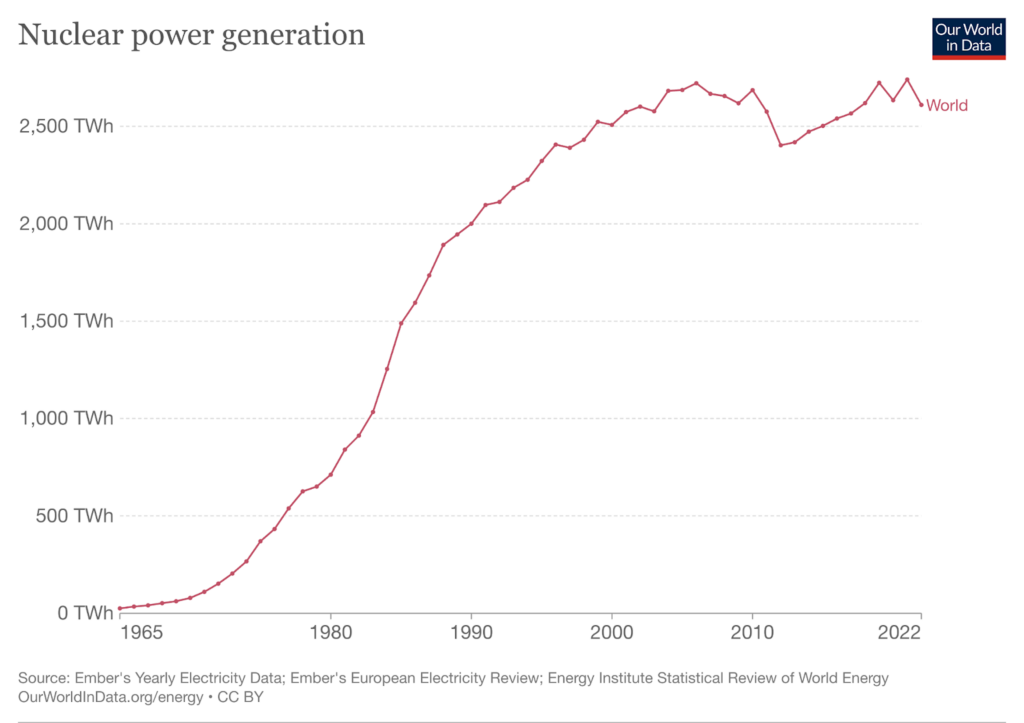
The 5 countries with the highest nuclear energy production (amount produced per year) are:
- US – 772 TWh
- China – 395 TWh
- France – 282 TWh
- Russia – 209 TWh
- Republic of Korea – 167 TWh
Some countries rely heavily on nuclear energy whilst others have not yet tapped into the resource. For example, nuclear energy provides roughly 60% of France, Slovakia, and Ukraine’s electricity, but South America and Africa get virtually no energy from nuclear. The top 5 countries represent roughly 70% of the world’s nuclear energy generation.
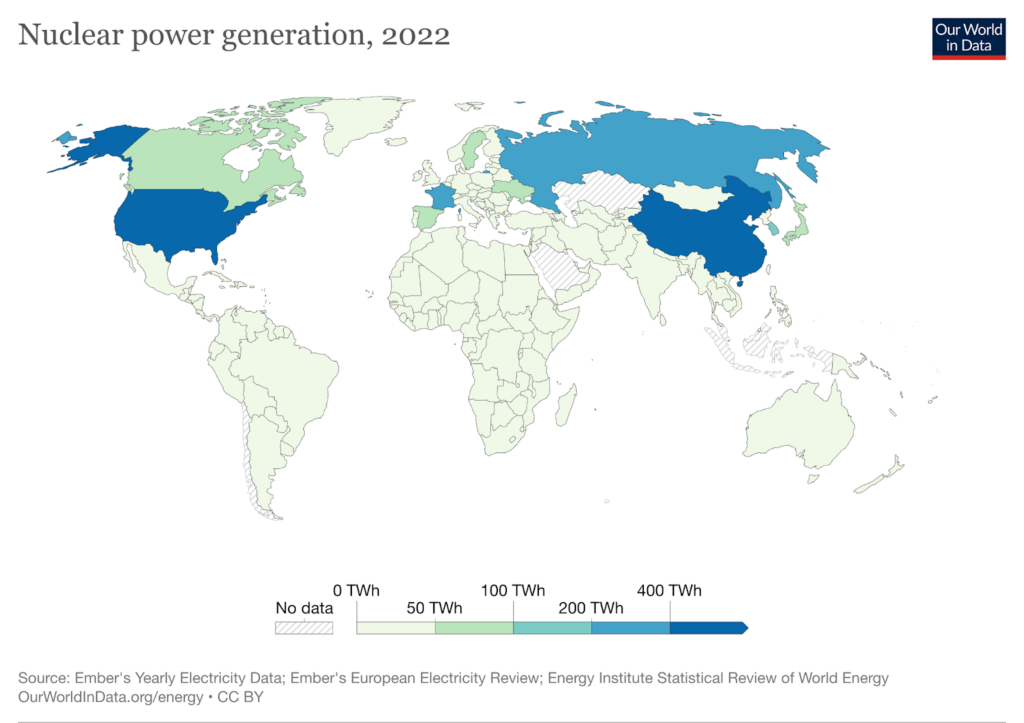
Nuclear energy helps avoid 1.5 gigatons of emissions per year and 180 billion cubic meters of global gas demand per year. In the past 50 years, nuclear energy has helped avoid over 70 gigatons of emissions. Going forward, nuclear will continue to be an important part of our energy mix.
How Will the Future of Nuclear Fission Look Like
Nuclear power faces an uncertain future. Although it can produce relatively emissions-free energy and adjust its energy output to compensate for shifts in renewable energy output, it also faces high upfront costs and negative public opinion.
How Nuclear Fission Will Likely Develop in the Future
Historically, the United States has led the way in terms of nuclear energy, with 93 operating commercial nuclear reactors at 54 nuclear power plants. But more recently, China has emerged as a global leader in nuclear energy.
China currently has 21 nuclear reactors under construction, two and a half times more than any other country, which will contribute an additional 21 GW of electricity. In comparison, the US only has 1 new reactor under construction which will contribute an additional 1 GW of electricity.
Overall, the IEA has labeled nuclear energy as ‘more efforts needed’ in their Net Zero by 2050 Scenario in terms of capacity and investments.
In terms of capacity additions, nuclear energy capacity must increase from 414 GW to 545 GW by 2030 to stay on track in the net zero scenario. Currently, there are about 60 nuclear reactors under construction in 15 countries, most notably in China, India, and Russia.

In terms of funding, nuclear investment must triple to $125 billion per year to stay on track in the net zero scenario. Investment averaged only $40 billion per year from 2016-2022, but the Intergovernmental Panel on Climate Change (IPCC) predicts global investments to increase to over $100 billion per year through 2050.
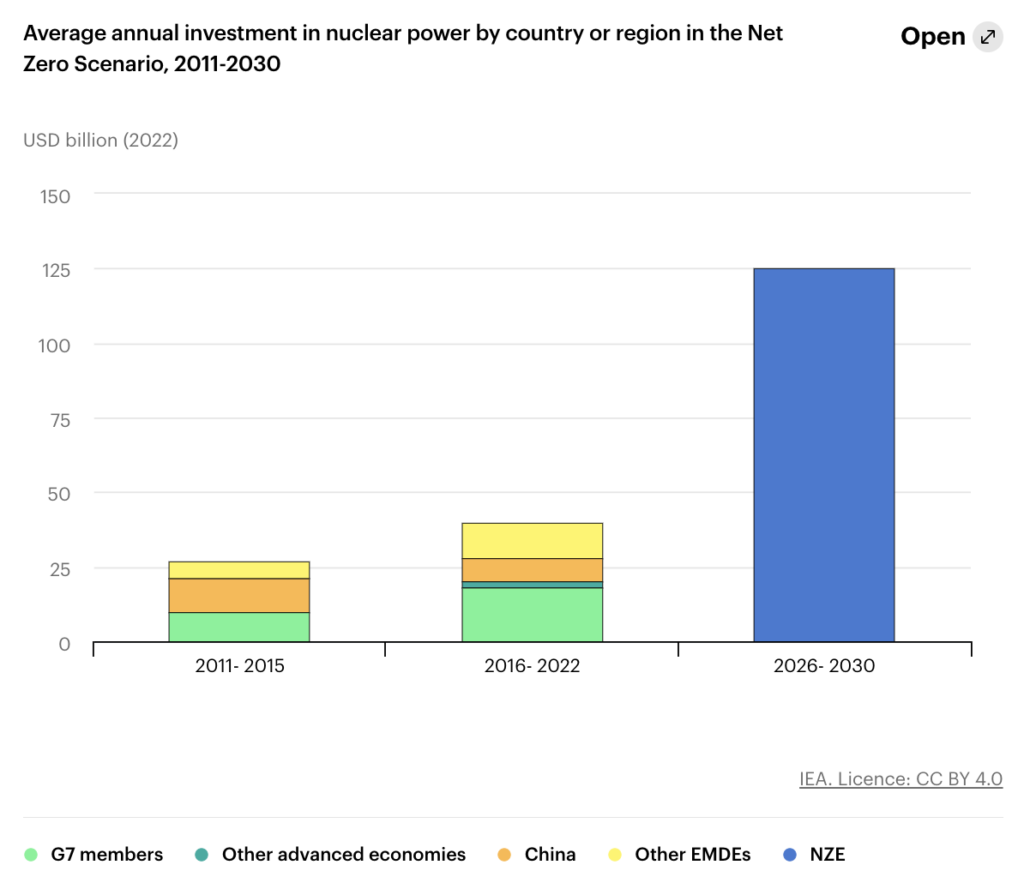
What Policies Are Put in Place to Support Nuclear Fission Usage
The most well-known piece of legally binding, international climate mitigation legislation is The Paris Agreement, the goal of which is to limit global warming to below 2 degrees Celsius (C), preferably to 1.5C, compared to pre-industrial levels.
The Paris Agreement specifically notes a transition towards clean energies, such as nuclear energy, as being a critical part of meeting these goals.
Check out the highlights of the 2015 COP21 directly from the UN Climate Change channel:
In addition, The International Energy Agency’s (IEA) Net Zero Emissions by 2050 Scenario is one framework for the global energy sector to achieve net zero CO2 emissions by 2050 and universal energy access by 2030.
There are many global and country-specific nuclear policies and organizations aimed at meeting the 2050 net zero scenario, including:
- 1957 – International Atomic Energy Agency (IAEA): The IAEA was founded as fears about nuclear technology began to develop. It is an organization within the United Nations that seeks to promote the safe, secure, and peaceful use of nuclear technologies through international cooperation.
- 1974 – The International Energy Agency (IEA): The IEA was founded in response to the major oil disruptions in 1974. It promotes international energy cooperation, including nuclear energy, and is made up of 31 member countries.
- 1994 – Nuclear Energy Institute (NEI): The NEI was founded as the policy organization of the nuclear energy industry. They seek to promote the global growth of nuclear energy through effective policies.
- 1998 – World Nuclear Transport Institute (WNTI): The WNTI was founded to represent the collective interests of the nuclear transport industry. They aim to ensure safety and security in the global transport of nuclear materials.
- 2001 – World Nuclear Association (WNA): The WNA was established as the leading international organization to represent the global nuclear industry.
If you are interested in learning more about country-specific nuclear energy policies, you can visit the IEA’s nuclear power policy database.
What Are Currently the Different Types of Nuclear Energy
In general, nuclear energy is generated when neutrons either fuse or divide, which releases heat, produces steam, spins a turbine, and drives generators to produce electricity. The two ways we can generate nuclear energy are via nuclear fission or nuclear fusion.
Nuclear Fission Is How We Currently Produce Nuclear Energy
Nuclear fission is the process by which neutrons are used to split the nucleus of an atom, which releases an enormous amount of energy in the form of heat and radiation.
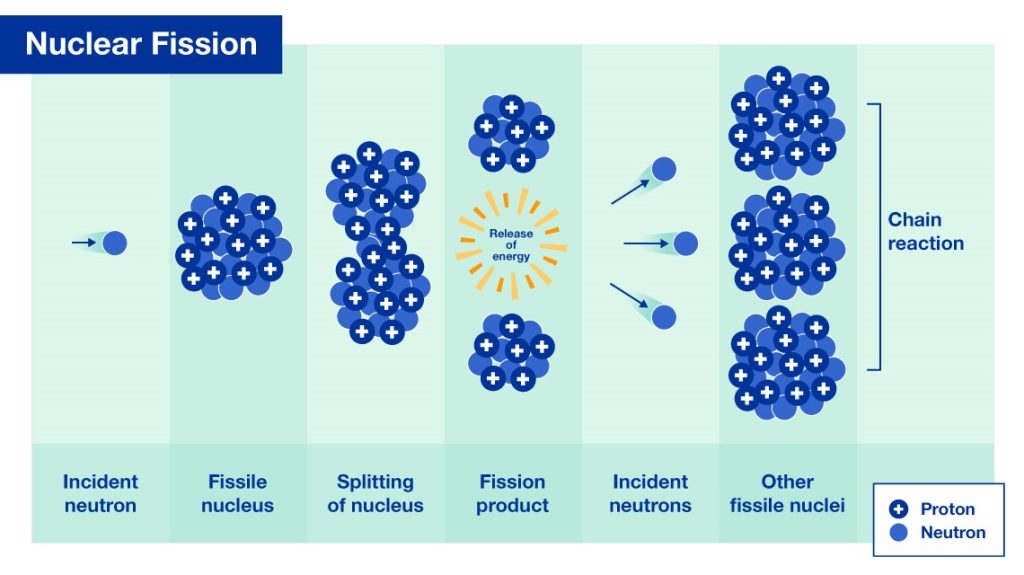
Uranium-235 (U-235) is the isotope of Uranium used in nuclear fission because its atoms are easily split apart in nuclear reactors. Each time the reaction occurs, more neutrons are free to strike more and more nuclei, causing a chain reaction which turns a turbine and spins a generator to produce electricity.
Nuclear fission is expected to continue to play a key role in the clean energy movement. This is because nuclear energy:
- Has a low carbon footprint: On a life-cycle basis, nuclear energy (nuclear fission) emits 12 grams of CO2 equivalent per kilowatt-hour (kWh) of electricity produced, which is tied for the third-lowest out of all energy types.
- Has a minimal land use impact: Nuclear power produces more electricity on less land than any other clean-air source. A standard, 1,000-megawatt facility requires only a little more than 1 square mile to operate, a number that is 360 and 75 times less than what is required for wind farms and solar power plants, respectively.
- Generates very little waste: A typical 1,000-megawatt facility produces only three cubic meters of nuclear waste. In comparison, the average coal-fired power plant produces roughly 300,000 tons of coal ash and more than 6 million tons of CO2 every year.
- Promotes energy security: Nuclear energy contributes to energy security by increasing the stability of our power grids. Unlike renewable energy, which faces variations in supply and demand, nuclear energy can provide a reliable and consistent source of clean energy.
Nuclear Fusion Is Still in the Research and Development Phase
Nuclear fusion is the process by which lighter atoms are combined or fused to create larger and heavier atoms. Nuclear fusion is still very much in the research and development phase.
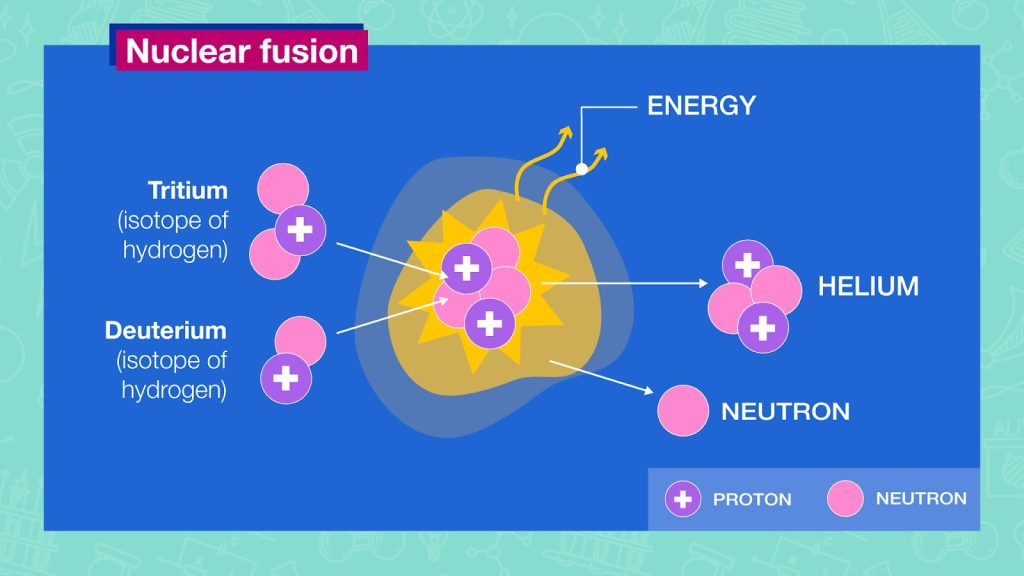
Fusion reactions take place in plasma, a hot, charged gas made of positive ions and free-moving electrons. Deuterium and Tritium, isotopes of hydrogen with extra neutrons, are most commonly used as the fusion material. In theory, it is possible to produce a terajoule of energy, enough to meet the needs of an adult person living in the developed world for 60 years, with just a few grams each of Deuterium and Tritium.
The sun and stars get their energy from nuclear fusion, as hydrogen atoms fuse together to form helium and matter converts into energy. However, this process is very hard to control within a laboratory setting. More still needs to be done to determine if this could be another viable energy source.
Final Thoughts
The early history of nuclear fission dates back to the late 1800s, with studies about the science of atomic radiation and the atomic model. When Enrico Fermi unknowingly directed the first man-made nuclear chain reaction in 1934, he kickstarted the nuclear energy movement. Once the nuclear fission process was experimentally and theoretically verified in 1938, the industry saw rapid growth in response to World War II.
Nuclear energy is currently our second-largest source of low-carbon energy behind hydropower energy. The formation of the International Energy and World Nuclear Association plus the implementation of the Paris Climate Agreement Climate has propelled nuclear energy into the spotlight as one replacement for traditional fossil fuels.
Nuclear power faces an uncertain future. Although it can produce relatively emissions-free energy and adjust its energy output to compensate for shifts in renewable energy output, it also faces high upfront costs and negative public opinion. However, experts still predict nuclear energy will continue to play a key role in the clean energy movement for years to come.
Stay impactful,

Sources
- The International Atomic Energy Agency: What is Nuclear Energy? The Science of Nuclear Power
- Nuclear Energy Explained: All You Need to Know
- Britannica: Fissile Material
- Britannica: Uranium-235
- US Department of Energy – Office of Nuclear Energy: Fission and Fusion: What is the Difference?
- The International Atomic Energy Agency: Homepage
- The International Energy Agency: Homepage
- The World Nuclear Association: Homepage
- The World Nuclear Association: What is Uranium? How Does it Work?
- The Atomic Heritage Foundation: Timeline – Nuclear Museum
- The Nobel Prize: Henri Becquerel
- US Energy Information Administration: Nuclear Timeline
- Britannica: J.J. Thompson
- Britannica: Rutherford Model
- Britannica: Ernest Rutherford
- National Library of Medicine – National Center for Biotechnology Information: Frederick Soddy – Pioneer in Radioactivity
- US Department of Energy: Manhattan Project – A Miniature Solar System
- Britannica: Niels Bohr
- US Department of Energy: Manhattan Project – Exploring the Atom
- World Nuclear Association: Nuclear Power in the World Today
- The History of Hydropower Energy: The Big Picture
- Britannica: Enrico Fermi
- Nobel Prize: Otto Hahn
- Britannica: Otto Hahn
- Britannica: Fritz Straßmann
- Britannica: Lise Meitner
- Britannica: Otto Robert Frisch
- World Nuclear Association: Outline History of Nuclear Energy
- Institution of Civil Engineers: Calder Hall nuclear power station
- Britannica: Calder Hall Reactor
- Our World in Data: Nuclear Energy
- The International Atomic Energy Agency: What is Nuclear Fusion?
- The International Atomic Energy Agency: Preliminary Nuclear Power Facts and Figures for 2019
- The International Atomic Energy Agency: Nuclear Power Proves its Vital Role as an Adaptable, Reliable Supplier of Electricity during COVID-19
- The International Atomic Energy Agency: Amid Global Crises, Nuclear Power Provides Energy Security with Increased Electricity Generation in 2021
- Statista: Capacity of nuclear power plants in operation worldwide from 1954 to 2022
- International Energy Agency: Nuclear
- World Nuclear Association: World Nuclear Performance Report 2023
- Our World in Data: Nuclear power generation
- Our World in Data: Nuclear power generation, 2022
- International Energy Agency: Executive summary – Nuclear Power and Secure Energy Transitions
- US Energy Information Administration: US Nuclear Industry
- CNBC: How China became the king of new nuclear power, and how the U.S. is trying to stage a comeback
- International Energy Agency: Nuclear power capacity by country or region in the Net Zero Scenario, 1990-2030
- World Nuclear Association: Plans for new reactors worldwide
- Intergovernmental Panel on Climate Change: Homepage
- Nuclear Energy Institute: Investing in the Future
- International Energy Agency: Average annual investment in nuclear power by country or region in the Net Zero Scenario, 2011-2030
- World Nuclear Association: Carbon Dioxide Emissions From Electricity
- US Department of Energy – Office of Nuclear Energy: 3 Reasons Why Nuclear is Clean and Sustainable
- World Nuclear Association: What is nuclear waste, and what do we do with it?
- United Nations Framework Convention on Climate Change: The Paris Agreement
- The International Energy Agency: Net Zero Emissions by 2050 Scenario
- Nuclear Energy Institute: Homepage
- World Nuclear Transport Institute: Homepage
- The International Energy Agency: Policies Database
- International Atomic Energy Agency: What is Nuclear Fusion?
- International Atomic Energy Agency: What is Nuclear Energy?
- World Nuclear Association: Nuclear Fusion Power
- Impactful Ninja: Nuclear Energy Explained – All You Need to Know
